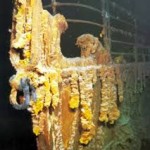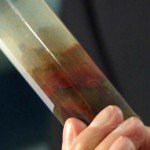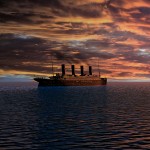 Back in 1912, the RMS Titanic set sail from Southampton, England. On board the ship, which at the time was the biggest in the world, there were over 2228 people, but on the fourth day of the voyage the ship struck an iceberg and sank killing over 1500 of the passengers and crew. The Titanic was one of the biggest disasters of the 20th century, and her rusted remains laid undiscovered for over 70 years. However, in 1985, an underwater explorer named Dr. Robert Ballard would explore the bottom of the ocean until the lost ship. Ballard then decided to take a closer look at the big ship, and not only did he discover she had split in two, but she was covered with long icicle-like objects he called rusticles. Upon closer examination, Ballard found out that these rusticles were not just rust, but bacteria that was slowly destroying the ship.
Back in 1912, the RMS Titanic set sail from Southampton, England. On board the ship, which at the time was the biggest in the world, there were over 2228 people, but on the fourth day of the voyage the ship struck an iceberg and sank killing over 1500 of the passengers and crew. The Titanic was one of the biggest disasters of the 20th century, and her rusted remains laid undiscovered for over 70 years. However, in 1985, an underwater explorer named Dr. Robert Ballard would explore the bottom of the ocean until the lost ship. Ballard then decided to take a closer look at the big ship, and not only did he discover she had split in two, but she was covered with long icicle-like objects he called rusticles. Upon closer examination, Ballard found out that these rusticles were not just rust, but bacteria that was slowly destroying the ship.
The Rusticles Were Collected and Studied
 Dr. Robert Ballard was one of the first humans to lay eyes on the RMS Titanic sink the night she sank into the North Atlantic. On September 1, 1985, he and a crew aboard a research vessel were hunting the bottom of the ocean for any signs of the legendary ship. Finally, when the crew started seeing debris, they knew it was more than just ocean garbage, but a long lost sunken ship. Four months later, Ballard and his team decided that it was time to get up close and personal with the long lost ship, and he used a mini submarine to do it. The drop to the bottom of the ocean took over two hours, and finally, Ballard was able to see the Titanic and the condition she was in. With her paint gone, and her surfaces covered with rusticles, it was very hard to tell that she was once the most beautiful ship in the world. During Ballard’s exploration, he collected a few samples of the big rusticles, and sent them to be analyzed. The results were that these structures were bacteria, and they were slowly puling the iron out of the ship.
Dr. Robert Ballard was one of the first humans to lay eyes on the RMS Titanic sink the night she sank into the North Atlantic. On September 1, 1985, he and a crew aboard a research vessel were hunting the bottom of the ocean for any signs of the legendary ship. Finally, when the crew started seeing debris, they knew it was more than just ocean garbage, but a long lost sunken ship. Four months later, Ballard and his team decided that it was time to get up close and personal with the long lost ship, and he used a mini submarine to do it. The drop to the bottom of the ocean took over two hours, and finally, Ballard was able to see the Titanic and the condition she was in. With her paint gone, and her surfaces covered with rusticles, it was very hard to tell that she was once the most beautiful ship in the world. During Ballard’s exploration, he collected a few samples of the big rusticles, and sent them to be analyzed. The results were that these structures were bacteria, and they were slowly puling the iron out of the ship.
A New Bacteria Has Been Discovered On the Titanic Wreck Site
 Ever since Dr. Ballard discovered, the ship has been studied thoroughly. Back in 2010, a proteobacteria was discovered on the ship. The bacteria was given the name Halomonas titancae, and this new predator has been able to adapt to the underwater environment remarkably well. Just how remarkably well has this super bacteria adapted? The osmolytes in the bacteria, which help with the fluid balance and cell volume, are giving the bacteria the ability to survive in even the harshest environments, such as the bottom of the ocean where there are extreme temperatures and incredible pressure. This bacteria now has the capabilities of surviving in salt water with an up to 25 percent saline concentration, which is eight times the amount of salt in the water where the Titanic lies.
Ever since Dr. Ballard discovered, the ship has been studied thoroughly. Back in 2010, a proteobacteria was discovered on the ship. The bacteria was given the name Halomonas titancae, and this new predator has been able to adapt to the underwater environment remarkably well. Just how remarkably well has this super bacteria adapted? The osmolytes in the bacteria, which help with the fluid balance and cell volume, are giving the bacteria the ability to survive in even the harshest environments, such as the bottom of the ocean where there are extreme temperatures and incredible pressure. This bacteria now has the capabilities of surviving in salt water with an up to 25 percent saline concentration, which is eight times the amount of salt in the water where the Titanic lies.
Experts have always said that the Titanic would eventually be gone, but their timeline was at least another century before this happened, but this new bacteria has quickly sped up that time. Experts are now saying that the Titanic will be gone in approximately 14 years. While the students of the Titanic disaster are undoubtedly upset by this news, the fact is that there are plenty of photographs and videos of the ship, which will last forever. Also, people need to remember that the Titanic changed the world, and while it happened back in 1912, people are still talking about it even 104 years later.
 The RMS Titanic sank on April 15, 1912, and for over 70 years, people were trying to find her. Finally, in 1985, Dr. Robert Ballard, and a crew of men and women aboard a research vessel, found the rusting remains of the Titanic. When Ballard went down to the bottom of the ocean, he discovered the ship was covered in long icicles that he named rusticles. When these rusticles were analyzed, they contained not only the iron from the steels, but also bacteria that was slowly destroying the ship. Named Halomonas titancae, this bacteria is very resilient, and in 14 years time, the Titanic will be no more. While the news of Titanic’s ultimate fate is upsetting, especially for those that study the ship, the fact is that there is still plenty of photos and videos of the ship that exist.
The RMS Titanic sank on April 15, 1912, and for over 70 years, people were trying to find her. Finally, in 1985, Dr. Robert Ballard, and a crew of men and women aboard a research vessel, found the rusting remains of the Titanic. When Ballard went down to the bottom of the ocean, he discovered the ship was covered in long icicles that he named rusticles. When these rusticles were analyzed, they contained not only the iron from the steels, but also bacteria that was slowly destroying the ship. Named Halomonas titancae, this bacteria is very resilient, and in 14 years time, the Titanic will be no more. While the news of Titanic’s ultimate fate is upsetting, especially for those that study the ship, the fact is that there is still plenty of photos and videos of the ship that exist.
Titanic will be gone in 14 years, but the fact is that her legacy will never die, and even if many centuries go by, she will always be sailing the North Atlantic in the imaginations of those that study her, and will continue to do so.

